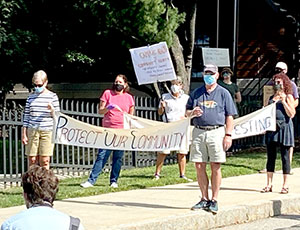
A small group of protestors gathered outside Tufts President Monaco’s home last week. The protestors are concerned that an influx of students will adversely affect the community at large.
By Denise Keniston
Tufts University is reporting three positive COVID-19 cases on its Boston Health Sciences Campus in Boston’s Chinatown. Patrick Collins, Tufts Media Relations Executive Director, confirmed the three cases on Monday, August 24.
“So far, the University has conducted 5,321 tests involving 2,993 people. There have been three positive test results, a very low rate,” said Collins. “All three of the positive test results are on the Boston Health Sciences campus; as of this writing, there have been no positive test results on the Medford/Somerville campus.”
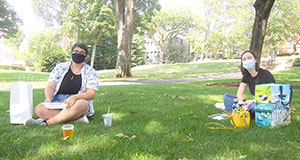
Second-year students Liam Romaker and Maggie Basinger have returned to campus for in-person learning from Ohio and California. Romaker says, “Nobody I know of wants to get sent home. We’re all following guidelines and doing what’s asked of us. We don’t want anyone to screw it up for us.”
Out-of-region students started coming back in mid-August. Those students must quarantine until they have three negative test results on days 0, 3, 6. Following the arrival and quarantine period of the out-of-region students, Tufts students who come from within the region (New York, New Jersey, Massachusetts, New Hampshire, Vermont, Maine, and Connecticut) will quarantine until they get one negative test result.
Liam Romaker and Maggie Basinger, are both second-year, out-of-region students. They have been testing negative in the several days they’ve been back on campus. Once they have tested negative three times they can move around on and off-campus with a mask. After the initial testing period is over, students (both on and off-campus) will be tested twice a week.
“The tests are very easy to do,” says Romaker. “You just swipe the swab up your nose, put it in a tube, and give it to a medical professional there monitoring the swab collections. It didn’t even take five minutes. We get the results very quickly.” Basinger says. “Students want to be on campus – many of us have worked hard to get here. I have a lot of confidence in President Monaco. I think his plan can work if everyone gets the tests, doesn’t have big parties, and wears a mask.”
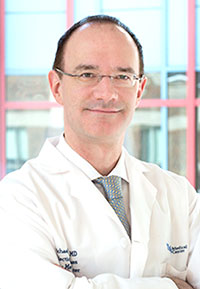
According to Tufts Infectious Disease Director Dr. Michael Jordan, data such as student behavior is woven into a very extensive predictive modeling matrix. For example, an RT rate of 2.5 indicates the serious spread of the disease. That is 80-100 infections which may indicate a closure.
The backbone of Tufts’ reopening plan is predictive modeling. Dr. Michael Jordan, Tufts Infectious Disease Director, says four early warning indicators feed real-time information into a predictive modeling matrix that Tufts is relying on for decisions, including a possible closure. One key indicator is the “RT rate” or “real-time reproductive rate” which helps measure how fast the virus is growing.
According to Dr. Jordan, the model is currently predicting an RT rate of 1.5 for returning students. That is 15 positive results. He says, “With respect to closure we have proposed that an RT rate of 2.5 would really indicate to us a serious epidemic or serious spread of infection on campus. An RT of 2.5 equates to 80-100 students infected at any given time.
Tufts is pushing forward with its reopening plan buoyed by the first week of negative test results for the Somerville/Medford campus. 5300 undergraduate students will be returning in total, with about two-thirds on campus and about one-third off-campus.
According to Rocco DiRico, Tufts Director of Community Relations, the plan is backed by science. “I know many people are concerned about off-campus enforcement and to that end, the university is conducting an extensive education and social norms campaign,” he says. “This will impress upon students the need to observe all protocols including masking and social distancing.”
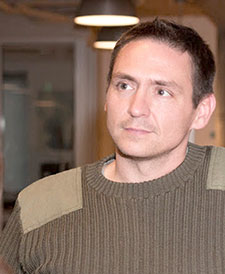
Ward 2 Councilor J.T. Scott says he has seen students walking around his neighborhood without masks.
Media reports of off-campus parties, like the one at Holy Cross where it has been confirmed a case of COVID-19 stemmed from an off-campus party, concern Somerville residents. Ward 2 Councilor J.T. Scott says he has already witnessed students without masks. “Why the hell am I seeing students wandering around the square without masks on?” he asks of Tufts officials. “I know my neighborhood. These kids just got back. Does quarantine mean something other than what I think it means?” According to Tufts, one possible explanation is those students may have been living in Somerville all summer and, as such, need only one negative test.
Tufts has recently decreased the number of returning students. Roughly 1600 students are learning remotely. As of Monday, August 17, Rocco DiRico said remote learning students are not required to be tested.
Somerville Councilor At-Large Mary Jo Rosetti believes data will show many remote learning students are actually residing in Somerville because they have signed leases. She says, “I’m concerned. I think there’s going to be a large number of the population receiving remote education who in fact are living in Somerville, who opted for remote but were stuck into a lease so they’re still living here, but now they’re not bound to be tested. That highly raises a red flag for me.”
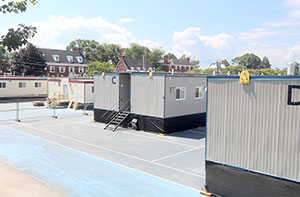
“Mods” – located in the tennis courts on campus – can accommodate hundreds of sick students at once. Tufts President Monaco says any student that tests positive will be kept here and monitored by health professionals.
Residents are also concerned. On August 19, Somerville and Medford residents gathered outside Tufts University President Anthony Monaco’s house to protest. Marianne Walles, of Our Revolution Somerville PILOT, believes Tufts is not being transparent. “It’s the lack of transparency we’re concerned with,” she says. “Somerville is the most densely populated city in New England. What happens at Tufts isn’t contained to the campus!”
Somerville Mayor Joe Curtatone has not signed off on the Tufts reopening plan. He has asked Tufts administration to submit their plan to peer review, stagger the return of students, increase faculty and staff testing, and reduce the student population, among other things. He says, “We reserve the right to use the authority afforded to us here in the city of Somerville in the event these and other questions have not been sufficiently addressed.”
Tufts University will soon be making a dashboard publicly available so the community is aware of test results. For up-to-date information on Tufts’ reopening visit their website: https://coronavirus.tufts.edu.













Reader Comments